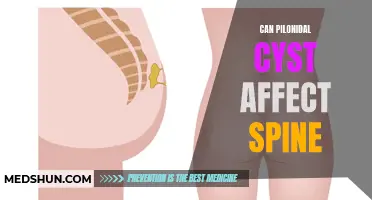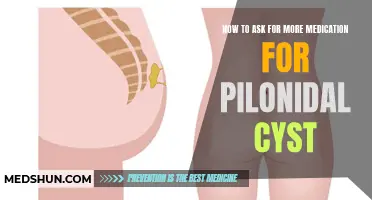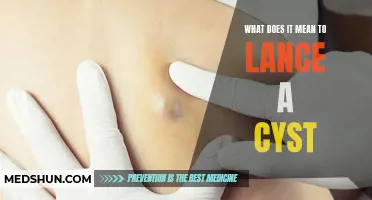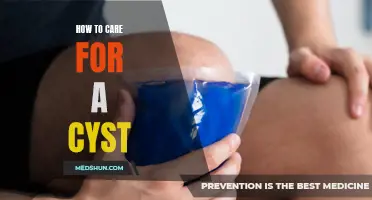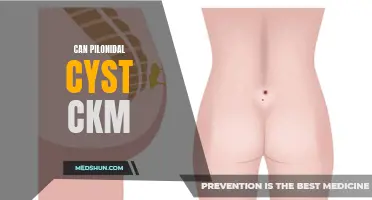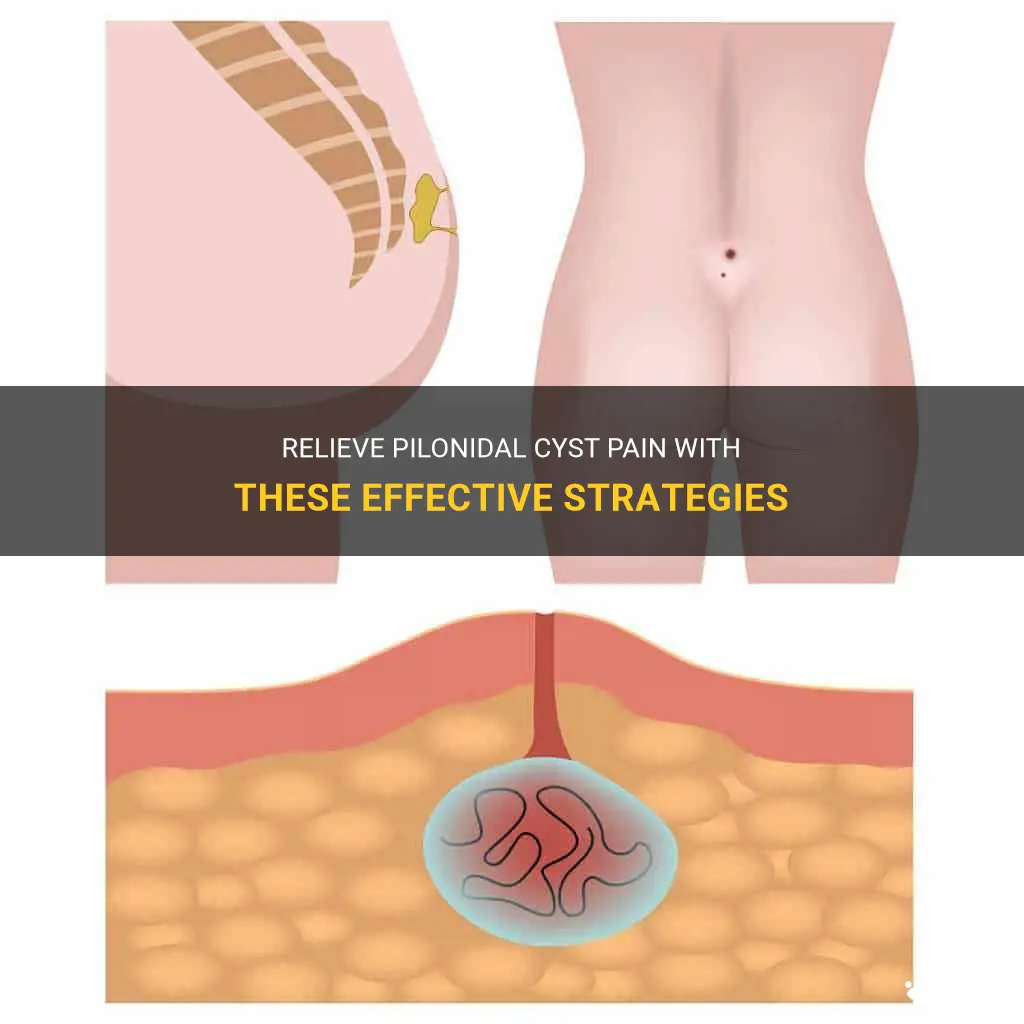
Are you tired of dealing with the excruciating pain caused by a pilonidal cyst? If so, you're not alone. Pilonidal cysts are a common ailment that can cause discomfort and frustration for sufferers. But fear not, as there are several effective ways to get rid of pilonidal cyst pain and find relief. From over-the-counter remedies to lifestyle changes, we've got you covered. So, sit back, relax, and get ready to kiss that pain goodbye.
| Characteristics | Values |
|---|---|
| Good hygiene | Yes |
| Warm compresses | Yes |
| Over-the-counter pain relievers | Yes |
| Antibiotics | Sometimes |
| Surgical drainage | In severe cases |
| Avoid sitting for long periods | Yes |
| Keep the area clean and dry | Yes |
| Use a cushion or pillow when sitting | Yes |
What You'll Learn
- What are some home remedies or over-the-counter treatments that can help alleviate pilonidal cyst pain?
- Are there any specific types of clothing or materials that should be avoided to prevent further irritation and discomfort?
- When should I consult a doctor or seek medical treatment for pilonidal cyst pain?
- What medical procedures or treatments are available for more severe cases of pilonidal cysts?
- Are there any long-term measures or lifestyle changes that can help prevent pilonidal cyst pain or recurrence?

What are some home remedies or over-the-counter treatments that can help alleviate pilonidal cyst pain?
Pilonidal cysts can be painful and bothersome, causing discomfort and irritation in the affected area. While it is always recommended to seek medical advice for proper diagnosis and treatment, there are some home remedies and over-the-counter treatments that can help alleviate pilonidal cyst pain. Let's explore some of these remedies and treatments in more detail.
- Warm compresses: Applying a warm compress to the affected area can help relieve pain and reduce inflammation. Use a clean, warm washcloth or a heating pad and hold it gently against the cyst for 10-15 minutes, several times a day. The warmth will help increase blood flow to the area, promoting healing and offering pain relief.
- Tea tree oil: Known for its antibacterial and anti-inflammatory properties, tea tree oil can be an effective home remedy for pilonidal cyst pain. Dilute a few drops of tea tree oil with a carrier oil, such as coconut oil, and apply it to the cyst using a cotton ball or swab. Repeat this process two to three times a day. Tea tree oil helps reduce inflammation and fights off bacteria, aiding in the healing process.
- Epsom salt baths: Soaking in a warm bath with Epsom salt can also provide relief from pilonidal cyst pain. The magnesium sulfate in Epsom salt helps reduce swelling and soothes the affected area. Add about half a cup of Epsom salt to warm bathwater and soak for 15-20 minutes. Repeat this once or twice daily until the pain subsides.
- Over-the-counter pain relievers: Non-prescription pain relievers, such as ibuprofen or acetaminophen, can help manage the pain associated with a pilonidal cyst. Always follow the dosage instructions and consult a healthcare professional if you have any existing medical conditions or are taking other medications.
- Proper hygiene: Maintaining good hygiene is crucial when dealing with pilonidal cysts. Gently cleanse the area with mild soap and water, pat dry, and avoid excessive rubbing or scrubbing. Keeping the area clean helps prevent infection and promotes healing.
- Avoid prolonged sitting: Prolonged sitting or pressure on the affected area can exacerbate pilonidal cyst pain. If you have a desk job or sit for extended periods, take regular breaks to stand or walk around. If sitting is unavoidable, use a cushion or inflatable pillow to relieve pressure on the cyst.
It's important to note that while these home remedies and over-the-counter treatments may provide temporary relief, they are not a substitute for medical treatment. If the pain persists or worsens, it is essential to seek medical attention. A healthcare professional can examine the cyst, prescribe appropriate treatments, and provide guidance on further management.
In conclusion, pilonidal cysts can cause discomfort and pain, but there are several home remedies and over-the-counter treatments that can help alleviate these symptoms. Warm compresses, tea tree oil, Epsom salt baths, over-the-counter pain relievers, proper hygiene, and avoiding prolonged sitting are some of the methods that can provide relief. However, it is crucial to consult a healthcare professional for proper diagnosis and treatment recommendations.
Tips for Getting a Good Night's Sleep Despite a Pilonidal Cyst
You may want to see also

Are there any specific types of clothing or materials that should be avoided to prevent further irritation and discomfort?
When it comes to choosing clothing that can irritate or cause discomfort, it is important to consider both the type of fabric and the fit of the garment. Certain materials and styles can exacerbate skin conditions such as eczema, dermatitis, and allergic reactions. By avoiding these specific types of clothing and materials, individuals can protect their skin and prevent further irritation and discomfort.
One material that should be avoided is polyester. Polyester is a synthetic fiber that is known to trap moisture against the skin, leading to increased sweating and potential irritation. This can be particularly problematic for those with sensitive skin or existing skin conditions. In addition to polyester, other synthetic fabrics such as nylon and acrylic should also be avoided for the same reasons.
Another material to avoid is wool. Many people develop an allergic reaction to wool, which can cause itching, redness, and hives. Wool can also be irritating for those with sensitive skin due to its coarse texture. If you must wear wool clothing, consider layering it with a soft cotton garment to create a barrier between the skin and the wool.
Tight-fitting clothing can also contribute to irritation and discomfort. When garments are too tight, they can rub against the skin and create friction, leading to chafing, redness, and even sores. This is especially true for garments with seams or tags that are in direct contact with the skin. Opt for looser, more breathable clothing to reduce friction and allow the skin to breathe.
In addition to considering the material and fit of clothing, it is important to avoid any clothing that has been treated with harsh chemicals or dyes. These can cause allergic reactions and skin irritation. Look for clothing that is labeled as hypoallergenic or made from natural, organic materials. These types of clothing are less likely to contain irritants that can exacerbate skin conditions.
To further prevent irritation and discomfort, it is also important to wash clothing with mild, fragrance-free detergents. Harsh detergents can leave behind residues that can irritate the skin, especially for those with sensitive skin or existing skin conditions. Choosing a gentle detergent and rinsing clothing thoroughly can help minimize irritation.
It is worth noting that everyone's skin is different, and what may cause irritation for one person may not affect another. It is important to listen to your body and pay attention to any signs of discomfort or irritation when wearing certain types of clothing or materials. If you notice repeated irritation or worsening of a skin condition, it is best to consult a dermatologist who can provide personalized advice and treatment options.
In conclusion, when it comes to choosing clothing to prevent further irritation and discomfort, it is best to avoid materials such as polyester, wool, and other synthetic fabrics. Opt for looser, more breathable garments and avoid tight-fitting clothing that can rub against the skin. Avoid clothing treated with harsh chemicals or dyes and opt for hypoallergenic or organic materials. Wash clothing with gentle, fragrance-free detergents to minimize irritation. By paying attention to these factors, individuals can protect their skin and prevent further discomfort.
Understanding the Anesthesia Process for Cyst Removal: Will You Be Put to Sleep?
You may want to see also

When should I consult a doctor or seek medical treatment for pilonidal cyst pain?
Pilonidal cysts are painful and often difficult to manage. They occur in the crease between the buttocks and can cause a variety of symptoms, including pain, swelling, and inflammation. While many cases can be managed at home with proper hygiene and care, there are certain situations where it is important to consult a doctor or seek medical treatment.
One of the primary reasons to seek medical treatment for pilonidal cyst pain is if the symptoms worsen or persist for an extended period of time. If you notice that the pain is increasing or if the cyst becomes more swollen or inflamed, it may indicate that the infection is spreading or that the cyst is becoming more severe. In these cases, it is important to consult a doctor to receive appropriate treatment and prevent further complications.
Another reason to seek medical treatment is if you develop a fever or if the area becomes hot to the touch. These can be signs of an infection that has spread beyond the cyst itself. Infections can be serious and may require antibiotics or even surgical intervention. If you experience these symptoms, it is important to consult a doctor as soon as possible to prevent the infection from worsening.
If you notice any drainage or pus coming from the cyst, it is also important to seek medical treatment. This can indicate that the cyst has ruptured or that an abscess has formed. Abscesses are collections of infected fluid that can be quite painful and require medical intervention to remove. A doctor can assess the situation and determine the best course of action, which may include draining the abscess or performing surgery to remove the cyst.
Finally, if you have a history of recurrent pilonidal cysts or if the cyst does not respond to home treatments, it may be necessary to consult a doctor. Recurrent cysts can be particularly stubborn and may require more aggressive treatment to prevent them from coming back. Additionally, if home treatments such as warm compresses, over-the-counter pain medications, and proper hygiene do not alleviate the pain or inflammation, it is important to consult a doctor for further evaluation and treatment.
In summary, there are several situations in which it is important to consult a doctor or seek medical treatment for pilonidal cyst pain. These include worsening or persistent symptoms, the development of a fever or hotness in the area, the presence of drainage or pus, and a history of recurrent cysts or non-responsive symptoms. By seeking medical treatment in these situations, you can receive the appropriate care and treatment to manage the pain and prevent further complications.
Understanding the Basics: What Is the Natal Cleft?
You may want to see also

What medical procedures or treatments are available for more severe cases of pilonidal cysts?
Severe cases of pilonidal cysts can cause significant pain and discomfort, and often require more extensive medical procedures or treatments. These more severe cases may involve recurrent cysts, abscesses, or fistulas that can be difficult to treat and may require intervention from a healthcare professional.
One common treatment option for severe cases of pilonidal cysts is incision and drainage. This procedure involves making a small incision in the cyst to drain any pus or fluid that has accumulated. After the drainage, the wound may be packed with gauze or left open to heal from the inside out. This procedure is typically done under local anesthesia and can provide immediate relief from the symptoms of the cyst.
In some cases, the cyst may be too large or complex for simple incision and drainage. In these instances, surgical excision may be necessary. Surgical excision involves completely removing the cyst and any sinuses or tracts that may have formed. This procedure is usually done under general anesthesia and may require a longer recovery time than incision and drainage.
In addition to incision and drainage or surgical excision, antibiotics may be prescribed to help fight any infection that may be present. Antibiotics are typically used in conjunction with other treatments and are not typically used as a standalone treatment for pilonidal cysts.
For severe cases of pilonidal cysts that are recurrent or resistant to other treatments, a more extensive procedure called a pilonidal cystectomy may be necessary. This procedure involves removing the cyst, the sinuses or tracts, and a portion of the surrounding tissue. A pilonidal cystectomy is a more invasive procedure and may require a longer recovery time.
After any medical procedure or treatment for pilonidal cysts, it is important to keep the area clean and dry to prevent infection and promote healing. This may involve regular cleansing with mild soap and water, applying antibiotic ointments or dressings, and avoiding activities that may cause excessive sweating or friction in the affected area.
In some cases, pilonidal cysts may require ongoing management and treatment. This may include regular follow-up visits with a healthcare professional, regular cleansing of the area, and possibly the use of topical or oral medications to prevent recurrence or manage symptoms.
In conclusion, severe cases of pilonidal cysts may require more extensive medical procedures or treatments such as incision and drainage, surgical excision, antibiotics, or a pilonidal cystectomy. It is important to consult with a healthcare professional to determine the best course of treatment for individual cases.
Will a Pilonidal Abscess Disappear on Its Own?
You may want to see also

Are there any long-term measures or lifestyle changes that can help prevent pilonidal cyst pain or recurrence?
Pilonidal cysts are fluid-filled sacs that form near the tailbone, usually at the top of the cleft of the buttocks. These cysts can cause pain, swelling, and infection if not properly managed. While surgical intervention is often necessary to treat pilonidal cysts, there are several long-term measures and lifestyle changes that can help prevent pain and recurrence.
- Maintaining good hygiene: Keeping the affected area clean and dry is crucial for preventing infection and recurrence of pilonidal cysts. Regularly washing the area with mild soap and water can help remove bacteria and debris that can contribute to cyst formation.
- Practice proper hair removal: Pilonidal cysts often occur due to ingrown hairs, so it is important to practice proper hair removal techniques. This may involve regularly shaving the area or using hair removal creams. Some individuals may also choose to wax or laser hair removal to reduce the risk of hair follicles becoming trapped and contributing to cyst formation.
- Avoid prolonged sitting: Sitting for long periods can put pressure on the tailbone area and contribute to the development of pilonidal cysts. If you have a desk job or spend a lot of time sitting, it is important to take regular breaks and stand or walk around to relieve pressure on the tailbone area.
- Wear loose-fitting clothing: Tight clothing, especially pants or underwear that are too tight, can exacerbate pilonidal cysts and increase the risk of recurrence. Opt for loose-fitting clothing that allows air circulation and reduces friction in the affected area.
- Maintain a healthy weight: Excess weight can put pressure on the tailbone area and increase the risk of pilonidal cysts. Maintaining a healthy weight through a balanced diet and regular exercise can help reduce the risk of cyst formation.
- Avoid activities that put pressure on the tailbone: Certain activities, such as horse riding or cycling, can put pressure on the tailbone area and increase the risk of pilonidal cysts. If you have a history of pilonidal cysts, it may be wise to avoid these activities or use cushions or padding to minimize pressure on the affected area.
- Regular check-ups: Even with lifestyle changes and preventative measures, it is important to have regular check-ups with a healthcare professional. They can monitor the area and provide appropriate treatment if any cysts or infections develop.
While these long-term measures and lifestyle changes can help reduce the risk of pilonidal cyst pain and recurrence, it is important to note that individual experiences may vary. If you have a history of pilonidal cysts, it is best to consult with a healthcare professional for personalized advice and guidance.
Finding the Right Doctor to Treat Your Cyst: A Comprehensive Guide
You may want to see also
Frequently asked questions
Yes, over-the-counter pain relievers such as ibuprofen or acetaminophen can help alleviate the pain associated with a pilonidal cyst. These medications can provide temporary relief and help reduce inflammation. However, it is important to consult with a healthcare professional for proper dosage instructions and to rule out any potential complications.
While there are no home remedies that can cure a pilonidal cyst, there are a few measures you can take to help alleviate the pain. Applying warm compresses to the area several times a day can help reduce discomfort and promote drainage. Keeping the area clean and dry can also prevent infection and provide some relief. However, it is crucial to consult with a healthcare professional for proper diagnosis and treatment.
In most cases, surgical intervention is necessary to permanently eliminate pilonidal cyst pain. This typically involves draining the cyst, removing any infected tissue, and closing the wound. In some cases, a more extensive procedure may be required to remove the entire cyst and any sinus tracts. However, non-surgical approaches such as antibiotics or dressings may be initially tried depending on the severity of the cyst. Consulting with a healthcare professional is essential to determine the appropriate treatment plan.


